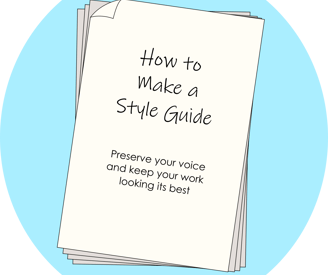
How to Make a Style Guide
Style guides are a great way to make sure your writing style and voice are preserved. However, not everyone knows what they are or how to make one. This blog explains the basics of a style guide and provides and example of one.
The most important rule I learned during my proofreading/copy editing course was consistency! As a writer, if you want to do something that goes against the Chicago Manual of Style or the Associated Press Stylebook, you absolutely can. But you want to keep it consistent. Regardless of the type of writing you do, consistency is important. Company blogs have a style that they follow so that readers become familiar with them. However, it can also be really difficult to remember what choices you made in niche situations or months ago in a post. So how do you remember all of your choices to keep things consistent? One way is to use a style guide.
What is a style guide?
It's a document where you note all those decisions you made about grammar and formatting. It can be a list in a word document or a similar program. It doesn't have to be fancy.
Why have one?
It's the easiest way to make sure that your writing style stays consistent. Hiring someone to write a post for your blog? Giving them a style sheet makes it easier for them to keep your style. Want someone to edit your work? An editor (like me) will use the style guide to know what counts as an error. While there are rules that editors follow, you may have specific things you like. The style guide tells us this and now we know that every time we see "x", we know how you want it to look. Consistent style helps the reader stay focused on the content and makes it easier to read. Having a style guide also helps you develop your brand and keeps your blog looking more professional.
Got it. So how do I make one?
An easy place to start is to open a Word document or a Google Doc and start noting decisions you make while writing. Do you like serial (Oxford) commas? Do you only want to spell out numbers up to 10? If something seems like common sense or you've seen it in other places, it probably doesn't need to be included in the style guide. Although, if there's a grammar rule that you really want to remember but constantly mix up (do I put the period inside the quotation marks or outside?), you can note it on the style guide as well, especially if it comes up often in the writing.
If you don't have a style guide, editors will likely make a basic one for themselves, especially for larger projects like books. If the author chooses to format all text messages in italics, the editor will note it on the style guide so that when it comes up 100 pages later, they can just look at their cheat sheet instead of trying to flip back through the book trying to find other examples. It saves time, which means you get results faster. If you give them a style guide at the start, that makes it even easier to edit while maintaining your style.
Another thing that's helpful is a word list. This can also be a simple list in Word or Google Docs. This document is really helpful if you have brand specific terms, technical jargon, or fantasy names of creatures and locations. You'd list all those terms, words that may have multiple spellings, or any other important words so that an editor or other writer would know what was used previously.
Are these documents necessary? No, but they are really helpful to make sure that your style is preserved throughout all of your work.
Want to see an example? Here's a copy of my style guide for my website and blog. I put it in a Google Doc so that I can access it wherever.
Let me know if there's another topic you'd like me to cover by using the contact methods below!


